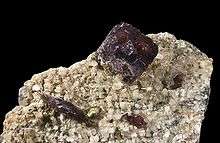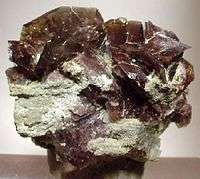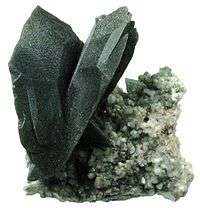Axinite
| Axinite | |
|---|---|
 Axinite – Deposit Topotype, France | |
| General | |
| Category | Cyclosilicates |
| Formula (repeating unit) | (Ca,Fe,Mn)3Al2BO3Si4O12OH or Ca2(Fe,Mn)Al2BSi4O15(OH) |
| Strunz classification | 9.BD.20 |
| Crystal system | Triclinic |
| Crystal class |
Pinacoidal (1) (same H-M symbol) |
| Space group | P1 |
| Identification | |
| Color | Reddish brown to yellow to colorless. Blue, violet, grey. |
| Crystal habit | Tabular, wedge shaped crystals |
| Cleavage | Good on {100} |
| Fracture | Conchoidal |
| Mohs scale hardness | 6.0–7.5 |
| Luster | Vitreous |
| Streak | White |
| Specific gravity | 3.18–3.37 |
| Optical properties | Biaxial (-) |
| Refractive index |
nα = 1.672–1.693 nβ = 1.677–1.701 nγ = 1.681–1.704 |
| Birefringence | δ = 0.011 |
| Pleochroism | Strong |
| References | [1][2] |
Axinite is a brown to violet-brown, or reddish-brown bladed group of minerals composed of calcium aluminium boro-silicate, (Ca,Fe,Mn)3Al2BO3Si4O12OH. Axinite is pyroelectric and piezoelectric.
The axinite group includes:
- Axinite-(Fe) or ferroaxinite, Ca2Fe2+Al2BOSi4O15(OH) iron rich, clove-brown, brown, plum-blue, pearl-gray[3]
- Axinite-(Mg) or magnesioaxinite, Ca2MgAl2BOSi4O15(OH) magnesium rich, pale blue to pale violet; light brown to light pink[4]
- Axinite-(Mn) or manganaxinite, Ca2Mn2+Al2BOSi4O15(OH) manganese rich, honey-yellow, clove-brown, brown to blue[5]
- Tinzenite, (CaFe2+Mn2+)3Al2BOSi4O15(OH) iron – manganese intermediate, yellow, brownish yellow-green[6]
Axinite is sometimes used as a gemstone.[7]
Gallery
 Clove-brown axinite crystals to 2.3 cm set atop matrix from the West Bor Pit at Dalnegorsk, Russia
Clove-brown axinite crystals to 2.3 cm set atop matrix from the West Bor Pit at Dalnegorsk, Russia Chloritized bladed crystals of Axinite forming on Adularia from the Swiss Alps
Chloritized bladed crystals of Axinite forming on Adularia from the Swiss Alps Tinzenite on Calcite, 4.5 x 3.5 x 3 cm. Wessels Mine, Kalahari manganese fields, Northern Cape Province, South Africa
Tinzenite on Calcite, 4.5 x 3.5 x 3 cm. Wessels Mine, Kalahari manganese fields, Northern Cape Province, South Africa-239862.jpg) Manganaxinite (Axinite-(Mn)), with sharp curving crystals to 4 cm. West Bor Pit at Dalnegorsk, Russia
Manganaxinite (Axinite-(Mn)), with sharp curving crystals to 4 cm. West Bor Pit at Dalnegorsk, Russia
References
| Wikimedia Commons has media related to Axinite. |
- ↑ Axinite Archived November 19, 2008, at the Wayback Machine.. Mineral Galleries
- ↑ Axinite. Mindat
- ↑ Handbook of Mineralogy: Ferroaxinite
- ↑ Handbook of Mineralogy: Magnesioaxinite
- ↑ Handbook of Mineralogy: Manganaxinite
- ↑ Handbook of Mineralogy: Tinzenite
- ↑ Tables of Gemstone Identification By Roger Dedeyne, Ivo Quintens p.147
This article is issued from
Wikipedia.
The text is licensed under Creative Commons - Attribution - Sharealike.
Additional terms may apply for the media files.